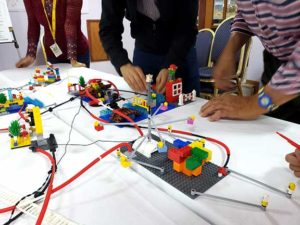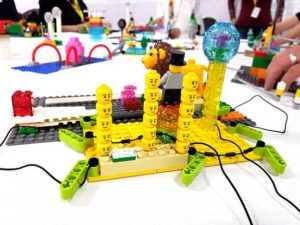“GO TO THE BRICKS,” he said. “When you don’t know what to do, go to the bricks. Don’t have a meeting with yourself.” As a perpetual holder of meetings with myself, these are some of my most powerful takeaways from LEGO® SERIOUS PLAY® facilitator training/certification with creator of the method, Robert Rasmussen.
Last week I flew to Mexico City for a four-day workshop. I visited CDMX briefly on a school trip in high school, but not in the 24 years since and in recent years, it moved higher and higher up my list of places to travel to. Having spent time in 30+ countries on six continents, CDMX quickly took a leading spot as one of my favorite cities around the globe. (And a brief side note for those of you who have only heard about Mexico City being a dangerous place you should avoid, as a solo female traveler, Ubering back and forth across the city, wandering around the Condesa neighborhood, through city parks, and eating alone in restaurants, my safety never felt compromised.) Sometime soon I’ll return with my family. But, I digress.
Back to the bricks…
LEGO® SERIOUS PLAY® is a problem-solving method with wide applications.
Coincidentally, it started right around the same time as Agile as was spinning up, in the early 2000’s. There are a number of parallels I will save for a later post.
 It involves getting hands-on with LEGO bricks to work through a series of facilitated prompts. LSP is a great tool to bring into team building and leadership development workshops, strategy sessions, determining what an MVP might look like for a new technology solution, self-empowerment, and as a vehicle for storytelling in the educational setting (these are just a few examples, with endless additional possibilities). It is best suited to conversations with a high degree of complexity where many options are on the table and the best way forward isn’t yet clear.
It involves getting hands-on with LEGO bricks to work through a series of facilitated prompts. LSP is a great tool to bring into team building and leadership development workshops, strategy sessions, determining what an MVP might look like for a new technology solution, self-empowerment, and as a vehicle for storytelling in the educational setting (these are just a few examples, with endless additional possibilities). It is best suited to conversations with a high degree of complexity where many options are on the table and the best way forward isn’t yet clear.
 Meetings are the bane of our workplace existences. They overwhelm, consume sometimes unsustainable amounts of time, often have no clear goals, agenda, or action items, and can result in poor morale, decreased innovation, and inefficiencies. The loudest voices frequently “win” with the quiet opinions never being surfaced. It doesn’t have to be this way.
Meetings are the bane of our workplace existences. They overwhelm, consume sometimes unsustainable amounts of time, often have no clear goals, agenda, or action items, and can result in poor morale, decreased innovation, and inefficiencies. The loudest voices frequently “win” with the quiet opinions never being surfaced. It doesn’t have to be this way.
 LSP engages introverts and extroverts alike, because conversations center around the “model” and everyone must speak about their models. It becomes less about a someone’s personal opinion and more about what they’ve represented in metaphor building with the bricks. The facilitator creates a safe space for all to engage. (As a side note, apparently LEGO is pretty particular about the language. I learned it’s a no-no to pluralize LEGO and instead, one should say LEGO bricks. You decide whether or not you want to add the extra syllable.)
LSP engages introverts and extroverts alike, because conversations center around the “model” and everyone must speak about their models. It becomes less about a someone’s personal opinion and more about what they’ve represented in metaphor building with the bricks. The facilitator creates a safe space for all to engage. (As a side note, apparently LEGO is pretty particular about the language. I learned it’s a no-no to pluralize LEGO and instead, one should say LEGO bricks. You decide whether or not you want to add the extra syllable.)
There are four elements of the core process:
- Pose a question
- Build
- Share
- Reflect
These steps are followed whether building individual or shared models. And it is intended to be “hard fun.” As Robert Rasmussen said during training, “If you immediately have the answer to the question, it is not hard enough.”
By applying the LEGO SERIOUS PLAY method, teams are able to unlock the knowledge that’s already there.
I’ve invested a lot of time, energy and money in higher ed and additional professional workshops and certifications. While I’ve never regretted investing in myself, some of those letters and diplomas have proven more valuable than others. Training to be a LEGO SERIOUS PLAY facilitator was the most engaging, thought-provoking workshop I’ve ever attended. And its ability to help me retain information shared by others was extraordinary.
I look forward to bringing the method out into the business world to make your next meeting less fruitless talk and more hands-on action.
For additional reading:


